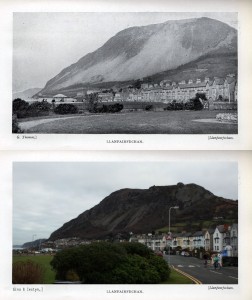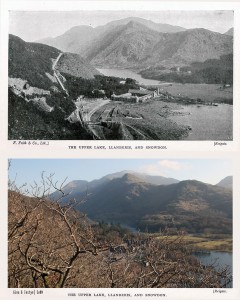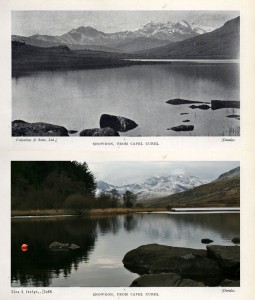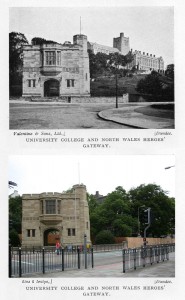
Llanfairfechan
Population – 3,638
Post Office. – In village; branch office towards eastern end of Penmaenmawr ROad.
Tennis at Victoria Gardens, towards eastern end of the Promenade, and at the Receration Ground, near Moel Yacht Pond. Tennis tournaments are arranged weekly during the season.
In it’s brief but merry course to the sea the little Afon Llanfairfechan dashes first through rocky, fern-clad gorges; then through the gradually widening valley in which the orignial village of Llanfairfechan stands and finally, passing under the coast road, it rattles past the modern resort called into visitors who appreciated this airy, healthy site on the verge of the sea yet within a stone’s-throw of the mountains. This charming contiguity of intrests is well illustrated by the stream which bubbles beside the main street of the village, for although its source is some 2,000 feet above the spot where it runs into the sea, yet it’s length is scarcely three miles. The eastern side of its valley terminates abruptly in the pominent headland know as Penmaenmawr Mountain; it’s western side falls away gradually in green, wooded hills above which giants of Snowdonia raise their heads to the sky.
The hills sufficiently far inland for thei majestic proportions to be seen and admired without the observer being oppressed with their too immediate proximity. Yet they are near enough for the ascent to begin at the door of the village post-office, and from any of them views of great beauty and variety may be had.
As the site has a gentle slope towards the sea, no great amount of moisture can remain upon the surface. Consequently the air is dry and bracing, and through the shelter afforded by neighbouring hills the climate is genial, as is demonstrated by fuchsias, myrtles, and other tender plants and shrubs – including the pale butterwort, a plant very sensitive to cold-flourishing all the year in open air.
The Sea Front at Llanfairfechan is unpretentious, but the bathing is safe and good, and the wide expanse of firm sand revealed by low tide forms a wonderland for children. There is a Green on which various games may be played and at either end of the Parade are public Tennis Courts and Bowling Green. A feature of even greater interest to the juvenile navigators – and their male relatives – is the Model Yacht Pond. It is regularly used by members of Liverpool and Wirral Model Yacht Clubs, and regattas are orginized during the season.
A feature distinguishing Llanfairfechan sea-front from many another is the View:-not the customary wide expanse of sea, but a charming panorama extending from the Great Orme’s Head across to Puffin Island, with it’s striped lighthouse, and then along the variegated coast of Anglesey to the tall roofs of Bangor, Penrhyn Castle rearing its battlement tower above the trees to the south-west, and then the eye travels round by the hills above Aber to remote Foel Fras and so round to the familiar scree-strewn face of “our mountain”.
It seems like Llanfairfechan, back in the day was the place to be! There’s an epic entry for the village in the book, and this is just an extract. I never thought of Llanfiarfechan to be a good place to be when going hill-walking, but I suppose the book is right, as from Llan you’ve got the whole of the Carneddau coming into play, before en counting the Snowdon massif. Very interesting to read this on Llanfairfechan. (Our North Wales – Northern Section book by Ward Lock & Co’s is dated 1930-1931)




